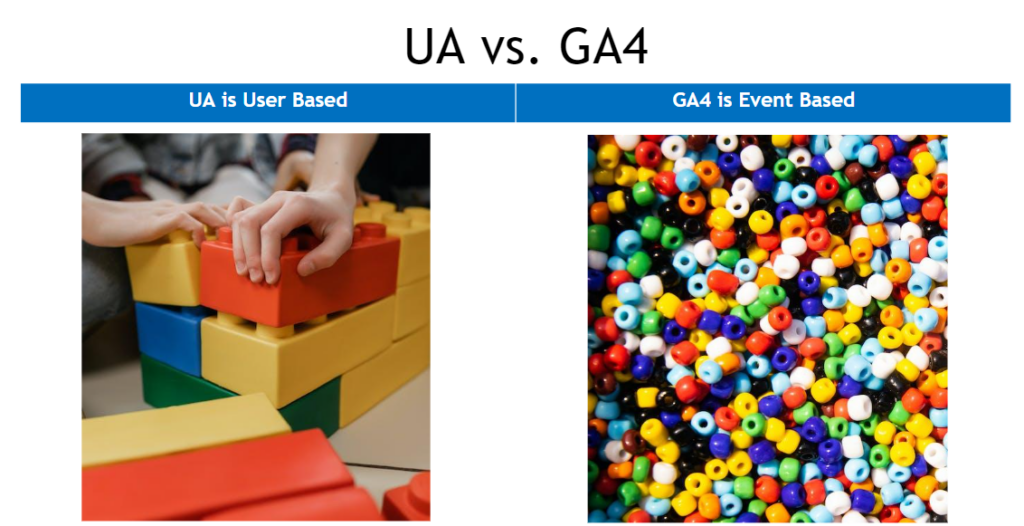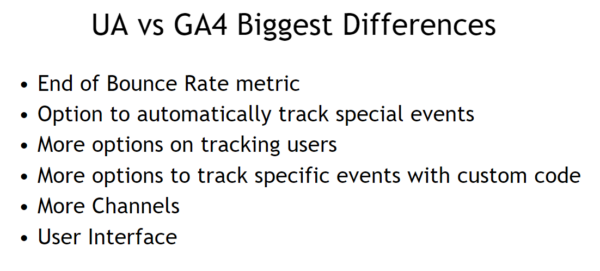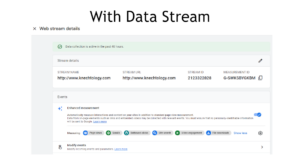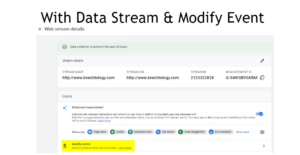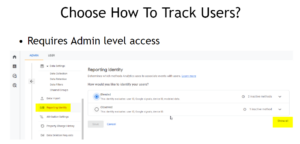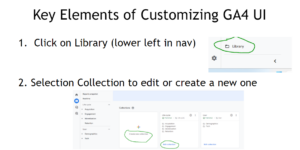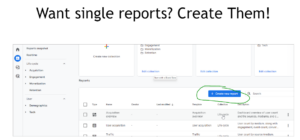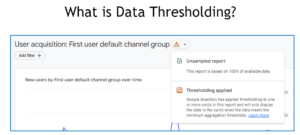You Will Actually Like GA4 After You Read This Recap: UA – GA3 With Alan K’necht
On May 17th, at the Womans Club in Fort Lauderdale, the impossible happened… Alan K’necht convinced a group of digital marketers and business owners at SFIMA that Google Analytics 4 is not only good…. It’s much better than Universal Analytics (A.K.A. Google Analytics 3).
We know, shocking. If the cameras weren’t there to record it, no one would have believed it.
But eternal Analytics nerd Alan K’necht was thorough in his discussion and convincing in his arguments. According to Alan, thanks to GA4, things have changed for the better.
There are many disbelievers and you may be one of them. For months people have been complaining about this switch.
“My marketing reports were going to have to change and I was going to have to learn a new piece of software that I use every day. And for what? Because Google has to make updates every few years to remain relevant?” We heard one marketer say.
As Alan said in his talk at SFIMA, “Anytime there’s a change, we are always uncomfortable. And when its thrust upon you, we all find what we don’t like and we focus on the differences.”
Let’s hear what Alan K’necht has to say about it.
The Biggest Differences Between GA4 and UA
Google Analytics may be the best step forward in reporting that Google has ever given us. That is not to say there aren’t drawbacks, limitations, and a few things that may not make much sense. But on the whole, Google Analytics 4 is far superior to its predecessor, Universal Analytics. Why?
Event-Based vs User-Based Data
Perhaps the most fundamental and all-encompassing difference between GA 4 and UA, is the very form of data tracking.
GA4 is all about event-based tracking, whereas UA was all about user-based tracking.
The difference there may be subtle but it is all too important.
GA4 uses event-based tracking, which means that you can track any interaction that a user has on your website or app. This includes things like clicks, scrolls, downloads, and purchases. Event-based tracking gives you a much more granular view of user behavior than traditional pageview and session tracking.
Alan says UA is structured like building blocks. “When a user visited your site while you were tracking using UA, the user got a cookie. If they don’t accept the cookie, no traffic was recorded.”
“In contrast, GA4 When you talk about event-based, each beed is a self-contained nugget of information.“
And the benefit is that event-based tracking lets us get more granular. The power is that we can create complex reporting… but according to Alan, “This is also why it seems more complicated”. But that event based tracking can give us more accurate data and a better understanding of what users are doing when they reach your website.
Ultimately, you can measure just how engaged they are. And the biggest example of new focus comes in the form of Google getting rid of the bounce rate.
Goodbye Bounce Rate
And Alan would say, good riddance. Bounce rate is defined as the percentage of visitors to a particular website who navigate away from the site after viewing only one page.
According to Alan, bounce rate can be a misleading metric because it may seem like there was only one pageview during a session. It’s easy to then consider that the session was a waste and that the user was not engaged.
However, if you focus on measuring events in this single session, it may tell a different story.
In GA4 you can create an event to measure how far down the page a user scrolls and how much time they spend on a page.
Where bounce rate may lead you to think that the user did not find the page helpful, the new data tracking in GA4 could give you a completely different view of that single session.
To understand exactly why Alan hates this metric, check out his article on if bounce rate is a junk metric here. He’s been arguing against it since 2017.
Data Collection is Different
More Accurate User Event Data
Your numbers are not going to make sense compared to previous years. And that’s because GA4 collects data very differently.
Most had no idea that Universal Analytics actually samples data when you run reports.
Alan gave an example. “Let’s say you have a million sessions in 12 months. Google will look at every other session, extract the data, and then multiply it by two to give you your data… your data was so wrong.”
That means that you could have worse data over a 6 months range as opposed to a 3 months range because the data is sampled and returns incorrect numbers.
Not great.
But that’s where GA4 comes in. Data collection is event-based and not sampled as a session but taken as exact events.
Cross-Platform Tracking through Google Signal
GA4 can track users across multiple devices and platforms. This means that you can see how users interact with your website or app on their phones, tablet, computer, and so on. Cross-platform tracking gives you a more complete view of user behavior and helps you to understand how they are using your products and services.
So how is this possible? It’s all thanks to Google Signals. If you have a Gmail account, chances are you allowed Google to track you and send ads to you when you first signed up.
Now Google Signal takes advantage of that tracking permission to provide more accurate user data to websites you visit. Your data is still private, but the website will know more about your online journey.
Privacy-focused
Now we can’t not talk about privacy after that revelation above.
GA4 is designed to be more privacy-focused than Universal Analytics. GA4 uses aggregated data and differential privacy to protect user privacy. Aggregated data means that the data is combined with data from other users so that it cannot be traced back to any individual user.
Differential privacy adds noise to the data so it’s more difficult to identify individual users. Overall, GA4 is a more powerful, flexible, and privacy-focused analytics platform than Universal Analytics. If you are looking for a way to get more insights into your users and their behavior, then GA4 is the better choice.
Machine learning
GA4 uses machine learning to provide more insights into your data. For example, GA4 can predict future behavior, identify trends, and recommend actions that you can take to improve your website or app.
Machine learning is a powerful tool that can help you to make better decisions about your business.
According to Alan, this is the “secret sauce” that we are not privy to as humble internet marketers and business owners.
Custom Interface
This may be the best new feature of GA4. You can customize your dashboard and take advantage of the new channels available through the interface.
Here are some of the new channels:
- Now paid and organic social
- Organic Shopping
- Paid Shopping
- Paid Video
- Organic Video
- Paid Video
You can find more information about these channels on the Google support page.
How to Setup Your GA4 To Measure Everything Correctly
Step 1: Push the button to begin your transition. You’ve seen the warnings for the past few weeks. Time to accept.
Step 2: Enable Enhanced Measurement. See below:
Step 3: Go to “Modify Events” and click “Add This Event to my Reporting”. See below:
Step 4: Visit the Reporting Identity tab. Be sure to click on “Blended”.
Step 5: Select “Turn on Google Signals”. If you cannot select this yet, then you have to come back and check on this again!
Here’s how to create a custom interface in GA4
Step 1: Click on the Library button in the lower left of the nav.
Step 2: Select a collection to edit or create a new one. See below
Step 3: Create a new collection
Step 4: Name the section via “create new topic”.
Step 5: Add reports by dragging and dropping them in the “search reports” section.
Step 6: Click on “Create New Report”. See below:
OR
Step 7: Publish the new report.
Cons of GA 4:
Okay, so it’s all so great right? Well not so fast. There are a few downsides to GA4.
Thresholding
If you come across numbers that do not make sense, keep an eye out for this little red triangle on your reports. This means your data is being affected by thresholding. Something Alan calls throttling.
According to Optizent, “data threshold is a feature in GA4 that is designed to prevent site visitors’ privacy. It withholds certain data from the reports so that anybody looking at GA4 data can not uniquely identify the users.”
The End of Free Analytics
According to Alan, “We have seen a lot of what they’re doing, and we have this feeling that they are trying to drive us to a paid model.”
The base core of GA4 is free… for now.
However, you only get data updated once per day and they are only storing data for 14 months. They want you to export your data to Big Query, a service associated with GA4.
So, if you want real-time updates that will require “what are called microcharges”. The charges are not high at all, sometimes a few dollars per month. But who knows what the future holds?
“Google came out for free and wiped out all the mid-tear paid solutions.”
Google has not released its charges. So it’s anyone’s best guess how much-paid analytics will cost.
This means for now, if they do begin to charge, there are no fewer competitors for them to face. Which means we will be stuck with Google Analytics for now.
Bottom Line
Google Analytics 4 (GA4) is a powerful tool that should be used by everyone interested in understanding their digital footprint because it delivers advanced insights into user behaviors, interests, and interaction patterns. It’s designed to adapt to a future with or without cookies, making it ideal for tracking across devices and platforms.
Its advanced machine learning capabilities predict the future actions of users, providing valuable information for marketing efforts. GA4 also improves data control, ensuring privacy compliance, while offering a free-to-use version that is accessible to all, from small businesses to large enterprises. Its cross-platform tracking provides a comprehensive understanding of the user journey, making it a vital tool for optimizing business strategies in the digital world.
In short, Google Analytics 4 is much better than UA. And it’s here to stay. So whether you like it or not, you’re going to have to get used to it.
Why not embrace it and get your mind wrapped around event-based tracking?
If you would like to know more about Alan K.necht. You can find him on all these channels:
Alan K’necht
@aknecht
Alan on LinkedIn
Knectology


